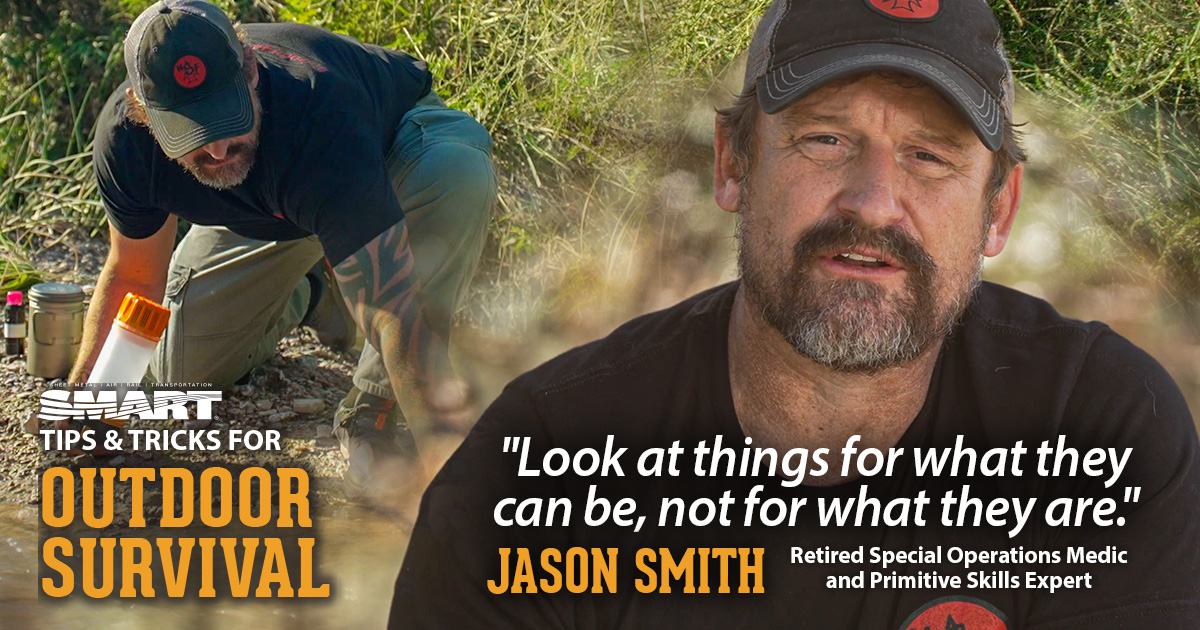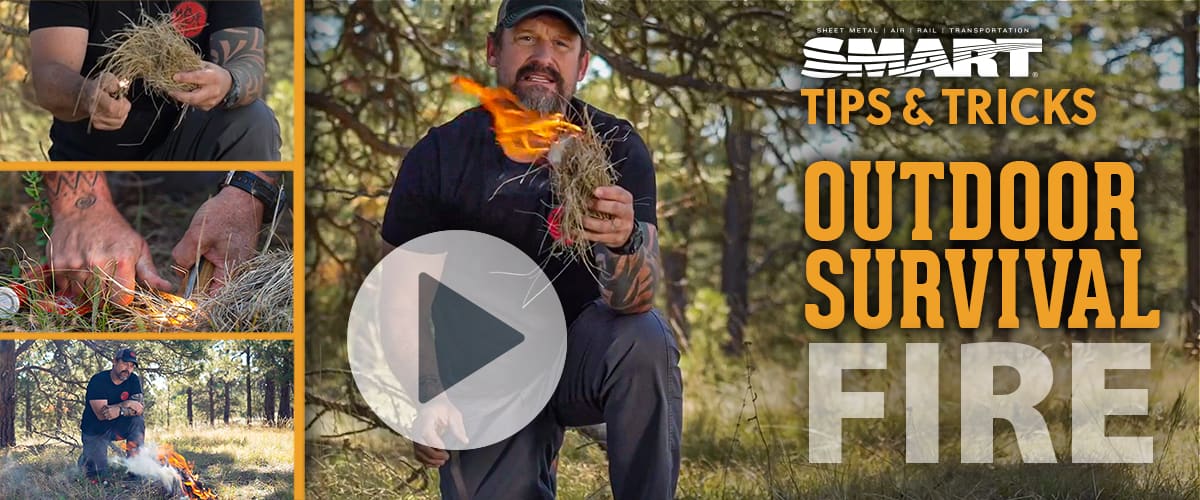
From Combat to Cutlery
Forging Ahead After a Lifetime of Service
by PJ DelHomme
The host of USA’s survival video series shares his skills acquired as a Special Forces combat medic and primitive skills instructor to help you stay safe, sound, and found the next time you take to the field.
Twenty years ago, on September 11, Jason Smith was a drill sergeant at Fort Jackson in South Carolina. He was having a cup of coffee when he heard the news that the U.S. was under attack. “For me, it was a reminder that we are not untouchable as a country,” he says. “I grew up in a Ranger battalion, and we prayed for war every day of our lives because that’s what we trained for. I joined the Army because I wanted to jump out of airplanes and go to war.”
Smith enlisted in the U.S. Army in 1992, nine years before 9/11. He was in Ranger school during Mogadishu (think Black Hawk Down) and got married in 1994. “And I still am,” he says, a little surprised but wholly proud of the accomplishment. After all, a resume like his isn’t exactly easy on relationships.
After 9/11, Smith served two combat tours as a medic with the 7th Special Forces group and two tours as a medic with the Special Missions Unit. He enjoyed his time in the service “more than you can imagine.” He didn’t go far when he retired from the Army in 2012. Growing up an Army brat himself, he was enthralled with survival techniques, and he has honed those skills since he was a kid. By the time he retired, word had spread about his knowledge of primitive skills, like starting a fire with a bow drill and brain-tanning animal hides.
He was asked to be an instructor for SERE courses (Survival, Evasion, Resistance, and Escape) at Ft. Bragg in Georgia. The job was a godsend. “I did it because I am absolutely passionate about the outdoors and survival,” he says. “And it filled the gap after getting out of the service. When you leave, nobody calls you anymore. The job at SERE helped fill that gap. My friends there all jumped out of airplanes.” He taught primitive skills at SERE for a decade, and according to his students, he’s pretty good at it.
“If you talk to anyone who went through SERE school, they will talk about how much they learned from him,” says Dave Smyth, who served with Smith in the Special Forces and now lives 20 minutes down the road from him in North Carolina. “I would hear story after story from Green Berets about him and his course. Anyone who has learned from him carries those lessons for years.”
In 2020, Smith and two other contestants competed on a survival show called Alone: The Beast. On the show, they were dropped off on a remote spot in northern Canada with nothing but the clothes on their back. They were provided with the carcass of a freshly killed moose. The goal was to see if they could survive 30 days in the wild. They did survive, and Smith’s team won.
Most recently, Smith was the host of USA’s latest video series “SMART Tips & Tricks for Outdoor Survival.” In the videos, he discusses survival techniques on everything from first-aid and fire to food and shelter. Today, Smith continues to teach survival courses and build custom knives with his company Hobo Forge Survival.
Practical Field First-aid
Smith isn’t short on stories, especially regarding his time as a medic. The Army crammed hundreds of hours of training into a year, and only half of his class graduated. Along with extensive emergency medicine training, Smith got a lot more. He learned how to take and read X-rays, deliver babies (which he did four times during his training), and pull teeth (which he did more than 40 times). “When you’re done with training, they send you out with a ton of knowledge and little practical application,” he says. “And you’re in Afghanistan, and people are getting shot. They look at you and want you to take care of it.”
While Smith’s training and experience surpass most hunters’ expertise, he’s quick to point out the need for hunters to have some basic first-aid knowledge. In addition, hunters should carry a very important piece of gear most have never even considered: a tourniquet. “Unless you’ve seen a femoral bleed before—and the horror on someone’s face as they’re bleeding out— it’s hard to understand why you need to carry one,” he says. Granted, IEDs are not an issue in the Pennsylvania hardwoods, but sticking a knife in your leg while dressing out a deer is a very real danger.
When you use knives in a cold environment, sometimes at high altitudes, you need to be more switched on, he says. And it’s almost worse when you have your buddies there to help. “You can have more hands than you can deal with. I’ve given classes where other guys have cut me because I’m holding a shoulder, and the other guy is talking and cutting at the same time.”
Smith has treated several “amputations on target,” which is why he carried at least one tourniquet per man on the team during missions. Each man also carried at least one tourniquet. Today, he has tourniquets stashed in the car, the house, the go bag—you get the idea.
The Survival Mindest
With Smith’s background in primitive skills, he was constantly amazed at the Afghan people who were essentially living a primitive life. “I mean, it was 2004, and everyone was living in a dirt hut. We watched people filling water in animal hides.”
At the same time, Smith admired the level of skill they had turning everything into a multipurpose item. “Afghans would pull the engine out of a tractor in the evening and set it up in an alcove,” he explains. “They would turn it on to run the electricity in the town and light up the bazaar area. It blew my mind.” This same mentality can be applied to hunters in the field.
Smith likes to say, “Look at things for what they can be, not for what they are.” Think about that. The Afghans certainly did when they repurposed that tractor engine. What about something as common as pine straw? Pine straw is tinder, but tinder isn’t pine straw, Smith tells his students. In other words, pine straw isn’t the only tinder in the woods. You can put some tinder in a single Ziploc bag, which can also be used to collect water or meat from a grouse. You can also use the bag to create a one-way valve to treat a sucking chest wound. That’s not what the executives at Ziploc may have had in mind, but it works.
“I teach guys how to survive with the gear they have left,” Smith says. The SERE courses he teaches are meant for any service member stuck in a bad spot who needs to avoid capture and get back alive like a pilot shot down behind enemy lines.
“Say you don’t have a knife. I am a gear guy, but I am passionate about primitive skills. And if you know what a knife can do, then you can make one in the field.”
Smith knows how to make a knife out of a lot of things, which is part of the ethos of his company, Hobo Forge Survival. He’s always been passionate about self-reliance, and when he was still in the military, he visited an Amish community. There, he learned a few things about working metal, bought his first anvil, and got into blacksmithing. He started making knives from whatever was lying around, like old truck parts and leaf springs. He shared those knives with co-workers.
When Smith talks about his knives and the forging process, he gets downright poetic. “Knifemaking is a therapeutic way to share my experience in the military with others. I’ve had four knee surgeries and broken all my fingers. I’ve been left with a lot of bumps and bruises, hammer marks, if you will. And I translate that into my work.”
As a soldier, Smith volunteered 30 years of his life serving our country. As a father, he’s raising his son to be a respectful, Christian man. As a small business owner who builds functional art and teaches others how to survive using their brain and the world around them, Smith is still following his dreams.
“All I want to do nowadays is share my passion with people and add value to other people’s lives.”
PJ DelHomme writes and edits content from western Montana. He runs Crazy Canyon Media and Crazy Canyon Journal.




